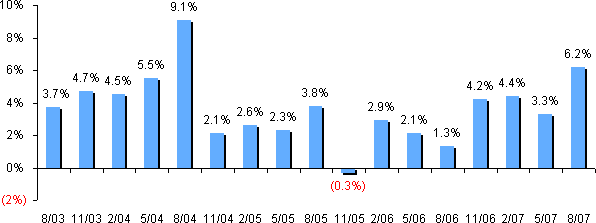IDEX Online Research: Lazare Kaplan Rough Diamond Margin Spikes
November 08, 07
For its fiscal quarter ended August 2007, Lazare Kaplan, a major rough and polished diamond supplier and jewelry producer, reported a 26 percent decline in revenues from the same period in 2006, but its gross margin (sales less cost of goods sold) more than doubled to 8.1 percent of sales versus 3.8 percent in the prior year’s period.
This trend occurred despite grumbling by diamantaires about weak margins as well as a declining value of the U.S. dollar, the international currency for rough and polished diamonds.
While Lazare Kaplan’s polished diamond margin in the August quarter was nearly flat at 12.0 percent of polished stone sales versus last year’s 11.7 percent, the company’s rough diamond margin spiked to 6.2 percent of rough diamond sales, well ahead of the 2.6 percent which it has averaged for the past three years. On a blended basis – roughly one-third of revenues came from polished stones in the quarter, up somewhat from last year’s 25 percent – Lazare Kaplan’s overall gross margin in the August quarter was 8.1 percent versus 3.8 percent last year.
The graph below summarizes Lazare Kaplan’s rough diamond gross margin by quarter since its fiscal year beginning in June 2003.
| Lazare Kaplan - Rough Diamond Gross Margin |
“Market Conditions Improve”
In its legal filings, Lazare Kaplan says that “increased rough gross margins reflect improving market conditions for certain categories of diamonds which the company chooses to sell in rough form and improved buying conditions in the Angolan informal sector.”
Market Conditions
The industry often describes prices and margins in the rough diamond market as “illogical,” and that could certainly be the case in today’s market. Despite wavering demand for smaller stones, rough diamond price increases continue to outpace polished diamond price gains. At some point, demand and supply should reach equilibrium, and rough diamond margins would settle into a tight range. With softer demand, it seems illogical that rough diamond margins would be so strong for Lazare Kaplan.
Indeed, Tiffany & Co characterizes its rough diamond margin as “low-to-no margin.” The diamond miners typically capture a large margin, but traders – who add virtually no tangible value – typically receive a depressed margin.
Further, the weakness in the U.S. dollar seems to have had little impact on rough or polished diamond prices. In theory, as the U.S. dollar declines, the value of the diamond inventory purchased in earlier periods with a stronger dollar is worth less. A diamond purchased for $1,000 today immediately loses value in the global market as the U.S. dollar continues falling. It may fetch $1,000 tomorrow, but that $1,000 is less valuable and will buy fewer rupees, South African rand or Euros than it did today. Further, accountants and banks demand that diamantaires value their inventory at lower of cost or market. Thus, as the U.S. dollar declines, the value of their diamond inventories also decline in the global market.
Angola Connection
As for Lazare Kaplan’s Angola operations, it is instructional to quote from the company’s recently released Annual Report to Shareholders: “Angola remains on track to become an ever more important force in the global diamond industry, as the country’s exploration, mining and trading sectors benefit from the country’s peacetime revival after some three decades of civil war.
LKI has built on its established track record in Angola by expanding both the breadth and volume of its activities, beginning with its ongoing contract with SODIAM – the parastatal legally charged with marketing Angolan diamonds – to buy rough stones produced in the informal sector and sell them globally. Increases in sales volumes through this channel have been enhanced by growth in the marketing of formal mine production by a freestanding entity, accounted for on an equity method, in which LKI holds a minority interest.
Meaningful progress has also been made in diversification into exploration for new diamond deposits, in what are considered by the world’s major diamond mining companies to be highly attractive conditions geologically.”
It is clear that rough diamonds coming from Angola have helped boost Lazare Kaplan’s margins, though it is not clear by how much. Last year, about 42 percent of Lazare Kaplan’s revenues were derived from its operations in Africa, but that occurred in many different countries.
Other Rough Diamond Traders Report Improved Margins
Again, defying logic, other rough diamond traders are reporting improved trading margins during that period. Many Sightholders, such as LKI, make a quick profit by selling their DTC boxes as soon as they get them, in fact sometimes in advance - even before the Sight starts. These sales generated margins of up to 20 percent during the quarter.
It is safe to assume that LKI did not refrain from this practice, and sold some of its DTC rough as soon as it could. How much they sold, and what boxes, is not known. Different boxes have different margins and that naturally changes during the year. We do believe that LKI generated some of its rough income from such sales.
